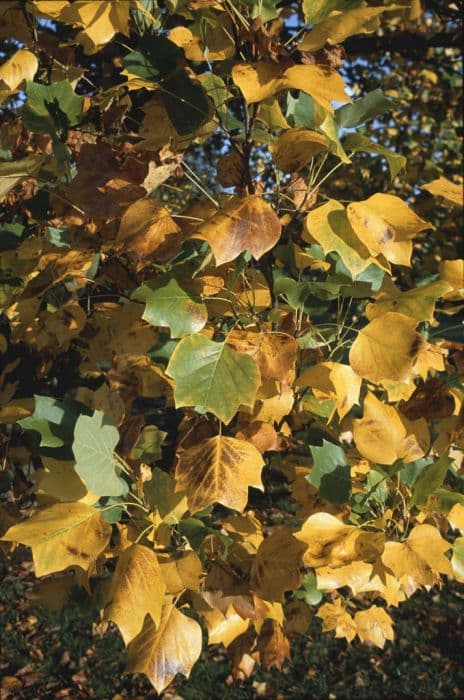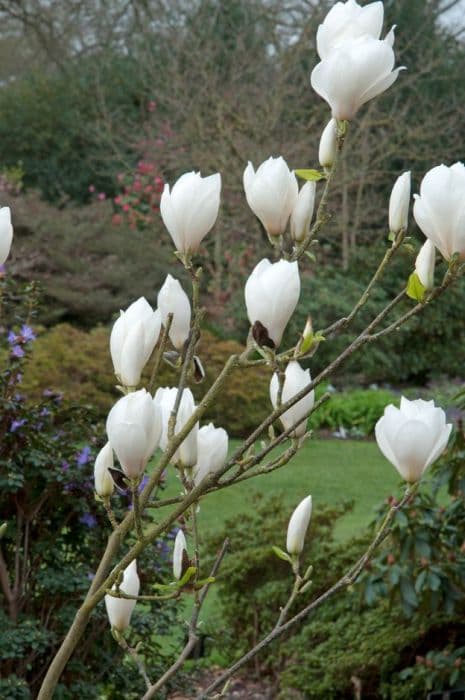Atlas Magnolia Magnolia 'Atlas'

ABOUT
Magnolia 'Atlas' is a captivating plant known for its large, showy flowers. The blooms of the Magnolia 'Atlas' are impressive, usually displaying a cup-shaped form with petals that can vary in color but often are shades of pink and cream, with a flush of rosy-purple on the outside, giving them a two-tone effect. Inside the blooms, the petals are mostly creamy-white, creating a striking contrast that catches the eye. The leaves of Magnolia 'Atlas' are broad and dark green, providing a lush backdrop for the magnificent flowers. The foliage often has a leathery texture, which makes it quite robust against various weather conditions. When the plant is not in bloom, its leaves continue to offer a verdant aesthetic that maintains the plant's appeal throughout the growing season. As the flowers bloom, they exude a sweet fragrance that can be described as citrusy or reminiscent of lemon, adding an aromatic dimension to its ornamental value. This characteristic scent often attracts pollinators as well as people who wish to enjoy the natural perfume in their gardens. Overall, the Magnolia 'Atlas' cultivar is valued for its dramatic floral display that can command attention in any landscape setting, creating a focal point with its dazzling large flowers and pleasant fragrance, complemented by its glossy, attractive foliage.
About this plant
 Names
NamesFamily
Magnoliaceae
Synonyms
Atlas Magnolia
Common names
Magnolia 'Atlas'
 Toxicity
ToxicityTo humans
Magnolia 'Atlas', commonly known as Magnolia, is not considered toxic to humans. There are no major concerns regarding the ingestion of parts of this plant, and it is not commonly associated with poisoning or adverse health effects in humans when touched or ingested in small quantities. However, as with any plant, individual allergies or sensitivities are always possible, and it is generally recommended to avoid consuming plant material that is not designated as edible.
To pets
Magnolia 'Atlas', commonly referred to as Magnolia, is generally considered to be non-toxic to pets such as dogs and cats. There are no significant toxic effects reported for pets ingesting parts of Magnolia plants. However, ingestion in large amounts could potentially lead to gastrointestinal upset, including vomiting or diarrhea, due to the non-digestible nature of the plant material, but this is relatively uncommon. Regular consumption of plant material by pets should be discouraged due to the potential for obstruction or other digestive issues.
 Characteristics
CharacteristicsLife cycle
Perennials
Foliage type
Deciduous
Color of leaves
Green
Flower color
Pink
Height
20-30 feet (6-9 meters)
Spread
10-15 feet (3-4.5 meters)
Plant type
Tree
Hardiness zones
5-9
Native area
Cultivar
Benefits
 General Benefits
General Benefits- Large, Showy Flowers: The Magnolia 'Atlas' blooms with exceptionally large, attractive flowers that are a focal point in any landscape.
- Aesthetic Appeal: It has a striking appearance with glossy green leaves and a beautiful structure, enhancing the visual interest of gardens.
- Fragrance: The blooms emit a pleasant fragrance that can create a soothing and inviting atmosphere in outdoor spaces.
- Shade Provider: As a large tree, it can offer considerable shade, making outdoor areas more comfortable during warmer months.
- Suitable for Various Landscapes: Adaptable to a range of landscape designs from formal to naturalistic settings.
- Wildlife Attraction: The flowers attract pollinators like bees and butterflies, supporting local ecosystems.
- Seasonal Interest: Provides year-round interest with its evergreen or deciduous leaves, depending on the climate, and striking spring blossoms.
 Medical Properties
Medical Properties- This plant is not used for medical purposes.
 Air-purifying Qualities
Air-purifying QualitiesThis plant is not specifically known for air purifying qualities.
 Other Uses
Other Uses- Culinary Garnish: The petals of the Magnolia can be crystallized or used fresh as a delicate garnish for desserts and salads.
- Natural Fabric Dye: The bark and flowers can be used to create natural dyes for fabrics, yielding shades of green or brown.
- Photography Subject: Due to its large, stunning flowers, Magnolia 'Atlas' is a popular subject for photographers, particularly in botanical and natural world photography.
- Artistic Inspiration: Artists often use Magnolia trees as inspiration and subject matter for paintings, drawings, and sculptures.
- Woodworking: Although not commonly used due to its rarity, the wood of the Magnolia tree can be used in woodworking for its fine texture and workability.
- Cinematography: Magnolias are frequently featured in films and TV shows to symbolize grace or to provide a visually captivating scene during spring.
- Fragrance Production: The scent of Magnolia flowers can be captured and used in the production of perfumes and scented candles.
- Educational Tool: Magnolia trees can serve as a resource for botanical studies, teaching about plant anatomy and pollination.
- Cultural Symbol: In some cultures, Magnolia is a symbol of purity and nobility, used in cultural ceremonies and artworks.
- Hide Tanning: The tannins found in the bark may be used for tanning hides in small-scale or traditional leather crafting.
Interesting Facts
 Feng Shui
Feng ShuiThe Magnolia tree is used in Feng Shui to attract purity and nobility. Often placed in the front yard, it can be utilized to enhance the welcoming energy of the home due to its beautiful and aromatic blossoms. In terms of the Bagua map, a Magnolia tree could be planted in the southwest area to boost love and marriage fortune or the east to support family harmony and health.
 Zodiac Sign Compitability
Zodiac Sign CompitabilityThe Magnolia is not used in astrology practice.
 Plant Symbolism
Plant Symbolism- Dignity: Magnolia flowers are often associated with dignity due to their grandeur and stateliness.
- Persistence: The hardiness of the magnolia tree, able to withstand harsh conditions, symbolizes endurance and perseverance.
- Feminine beauty: The soft and delicate petals of Magnolia flowers are symbols of feminine beauty and gentleness.
- Nobility: Magnolias have been historically related to nobility, representing elegance and grace.
- Peace and tranquility: The magnolia tree's calming presence is believed to bring about peace and serenity.
 Water
WaterThe Magnolia 'Atlas', or more commonly known as the Atlas Magnolia, requires watering that keeps its soil consistently moist but not waterlogged. During active growth in the spring and summer, water the Atlas Magnolia once or twice a week with around 2 gallons per session, depending on the weather conditions; during hot, dry periods, it may need more frequent watering. In the fall and winter, reduce the watering to once a week or less, as the plant's water requirements decrease. It’s important to check the soil moisture level before watering to ensure it is not already saturated.
 Light
LightAtlas Magnolia thrives best in full sun to partial shade. Ideally, it should receive at least 4 to 6 hours of direct sunlight daily. A spot where the plant is protected from the harsh afternoon sun would be optimal, as this can help prevent leaf scorch.
 Temperature
TemperatureThe Atlas Magnolia is hardy and can tolerate a range of temperatures; however, it grows best when the average temperature is between 70°F and 85°F. It should not be exposed to temperatures below 20°F to avoid frost damage, and during hot summers, it can endure temperatures up to around 95°F without harm.
 Pruning
PruningPrune the Atlas Magnolia to remove dead or damaged wood and to maintain its shape, with the best time for pruning being late winter or early spring before new growth begins. It's not required to prune annually but doing so every 2 to 3 years can help to keep the tree healthy and looking its best. When pruning, make clean cuts close to the branch collar for the best healing.
 Cleaning
CleaningAs needed
 Soil
SoilThe best soil mix for Magnolia 'Atlas', commonly known as the Magnolia tree, is a rich, acidic to neutral, well-draining loamy soil with a pH of 5.5 to 6.5. A mix containing peat moss, compost, and some pine bark can provide the necessary acidity and good drainage.
 Repotting
RepottingMagnolia 'Atlas' should be repotted every 3 to 5 years to prevent the plant from becoming pot-bound. Repotting is best done in late winter or early spring before the onset of new growth.
 Humidity & Misting
Humidity & MistingMagnolia 'Atlas' prefers moderate humidity levels. While these trees can tolerate some variation, maintaining a consistent humidity level that mimics their natural environment is beneficial.
 Suitable locations
Suitable locationsIndoor
Provide bright light, humid conditions, and don't let soil dry out.
Outdoor
Plant in partial shade to full sun, protect from harsh winds.
Hardiness zone
6-9 USDA
 Life cycle
Life cycleThe life of a Magnolia 'Atlas', commonly known as 'Atlas magnolia', starts with seed germination, which occurs when environmental conditions are favorable, usually in moist, well-drained soil. The seedling grows establishing a root system and shoots that develop into a woody stem. As the plant matures, it forms a distinctive woody trunk with a spreading canopy of large, glossy green leaves. After several years, the Magnolia 'Atlas' reaches reproductive maturity and produces large fragrant flowers, typically blooming in early spring to summer, signaling its readiness for pollination. Following pollination, the flowers develop into cone-like fruiting clusters which, when ripened, release seeds for the next generation. Over the years, the mature tree may reach significant heights and widths, continuing to bloom annually while requiring minimal maintenance, with potential longevity extending to 100 years or more under ideal conditions.
 Propogation
PropogationPropogation time
Spring-Early Summer
The most popular method of propagating the Magnolia 'Atlas' is by taking semi-hardwood cuttings in late summer. To do this, a cutting of about 4 to 6 inches (10 to 15 centimeters) long is taken from a healthy part of the plant, ideally with one or two leaf nodes present. The cutting's lower leaves are removed, and the cut end can be dipped into a rooting hormone to encourage root development. The prepared cutting is then placed into a pot with well-draining soil, kept moist, and covered with a plastic bag or placed in a propagator to maintain humidity. The cutting should be kept in indirect light until it roots, which can take several weeks, after which it can be gradually acclimatized to outdoor conditions.









